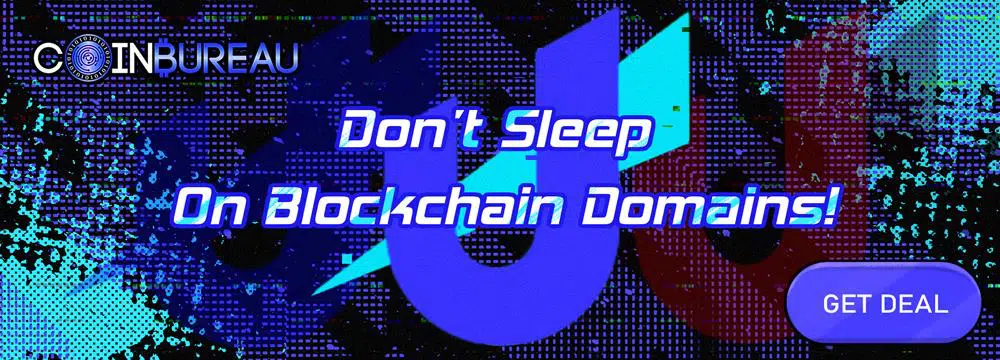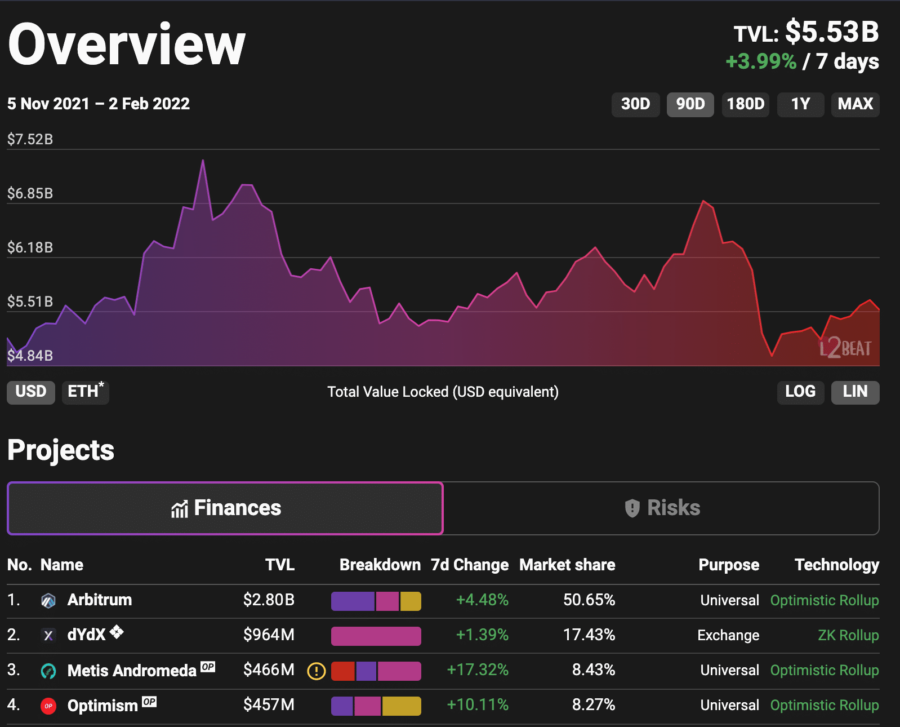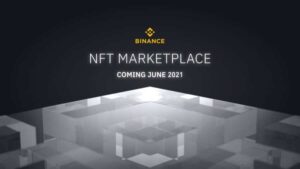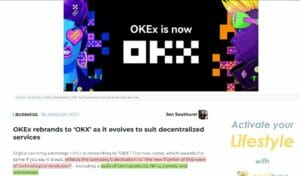Ethereum’s scaling issues and high transaction fees are general knowledge these days for almost anyone in the crypto world. The great thing about having one’s weaknesses exposed in such an open manner is that it also invites others who want to defend and protect it as it undergoes its evolution. ETH 2.0 is the path forward that is crucial to Ethereum’s survival. Having chosen sharding as the way to go, the ETH team has hunkered down to make sure both that and the transition to Proof-of-Stake goes through as smoothly as possible.
Optimistic Rollups
While the world waits for the Ethereum network to do the necessary, other ideas emerged to help with ETH’s issues and offer another way of moving the cryptoverse forward. One of these concepts is Optimistic Rollups. Similar to Bitcoin’s Lightning Network, where transactions occur away from the main blockchain, this concept batches transactions and, like rolling a carpet, bundles them together into a block and submits it together with an ETH bond for inclusion into the main chain. Just like the US justice system, which goes by the theory of “innocent until proven guilty”, these transactions are deemed honest and legitimate transactions by default until proven fraudulent.
Any node can issue challenges to question the validity of the proposed block within a set period such as seven days. If a node finds the block fraudulent, the proposed node’s bond gets slashed. On the other hand, if the challenger is proven wrong, the challenger’s bond gets slashed. Finally, if there are no successful challenges at the end of the period, the proposed blocks will get passed to the Ethereum main chain.
What Is Arbitrum
One of the blockchain projects using this concept is Arbitrum. Built on top of the Ethereum network (L1), this is a Layer-2 blockchain, or L2 shortened. Adopting optimistic rollups helps Ethereum solve the scalability issue, thus boosting the throughput for transactions, which in turn lowers the transaction fee as more transactions can get added to the block faster. Although transactions are processed on Arbitrum via ArbOS, the operating system that handles the transactions and collects fees, security for the transactions are still processed by the Ethereum network. So it’s essentially combining the best of both worlds.
The consensus mechanism used by Arbitrum to process transactions is known as the AnyTrust Guarantee. How this works is that all the validators need to agree for a block to be added. As long as there is one validator who disagrees, the block won’t be added to the blockchain.
The project’s primary target audience is developers, as it offers an ETH-friendly environment for them to build dApps without the costly fees. There are also various key features of the projects that we will point out in the following sections below.
Arbitrum Rollup
One of the ways to distinguish one type of rollup from another is the number of rounds of disputes required to resolve challenges. Arbitrum’s version uses the Multi-Round Interactive Optimistic Rollup. An on-chain contract referees the back-and-forth between the challenger and asserter. In addition, the amount of data on-chain is low.
EVM-Compatible and Ease of Use
Another highlight of Arbitrum is its high compatibility with the Ethereum Virtual Machine (EVM). In a nutshell, the EVM is the “computer” that runs the Ethereum network for smart contracts execution. Arbitrum has its own”supercomputer”, known as Arbitrum Virtual Machine (AVM), that underpins everything that is Arbitrum. On top of the AVM is ArbOS, mentioned earlier. The AVM supports the EVM architecture. This means that ETH developers can develop on Arbitrum just as if they are developing it on the Ethereum network itself.
In this sense, Arbitrum is positioning itself as the “home-away-from-home” option for ETH developers. Not only is it compatible with EVM, but it also natively supports all Ethereum development tools without any special add-on. This includes all smart contract languages like Solidity, which works just as well on Arbitrum. Therefore, dApps originally developed in Ethereum can easily move over to Arbitrum with minimal code changes. It’s never been easier to move dApps over, making it a most attractive option as the transaction costs are drastically lower than working on the Ethereum network itself.
Brief History
The project had a soft launch back in May 2021. By early July, two months later, about 300 dApps were running on it. The mainnet launch, known as Arbitrum One, was launched on Aug 31, 2021.
Arbitrum Ecosystem
L2s currently have a Total Value Locked (TVL) of $5.53 billion, of which Arbitrum has snagged $2.28 billion of it. That’s more than half the market share! This goes to show the popularity and belief from the Ethereum developer community. Let’s see what kind of dApps are actually on Arbitrum now.
Arbitrum Portal
“Your gateway to the Arbitrum ecosystem” is the first thing you see when you are at the Arbitrum Portal. There are five categories to choose from and one to see all the dApps running in the ecosystem. So let’s dive right in!
Wallets
There is no shortage of wallets to choose from that supports Arbitrum. Top names like Metamask, Coinbase, Trust, and MathWallet sit alongside lesser well-known ones such as DefiYield, LoopRing, Sequence, and Zapper. The wallets are used to help tokens get transferred (“bridged”) from L1 to L2 through the Arbitrum token bridge (mentioned below).
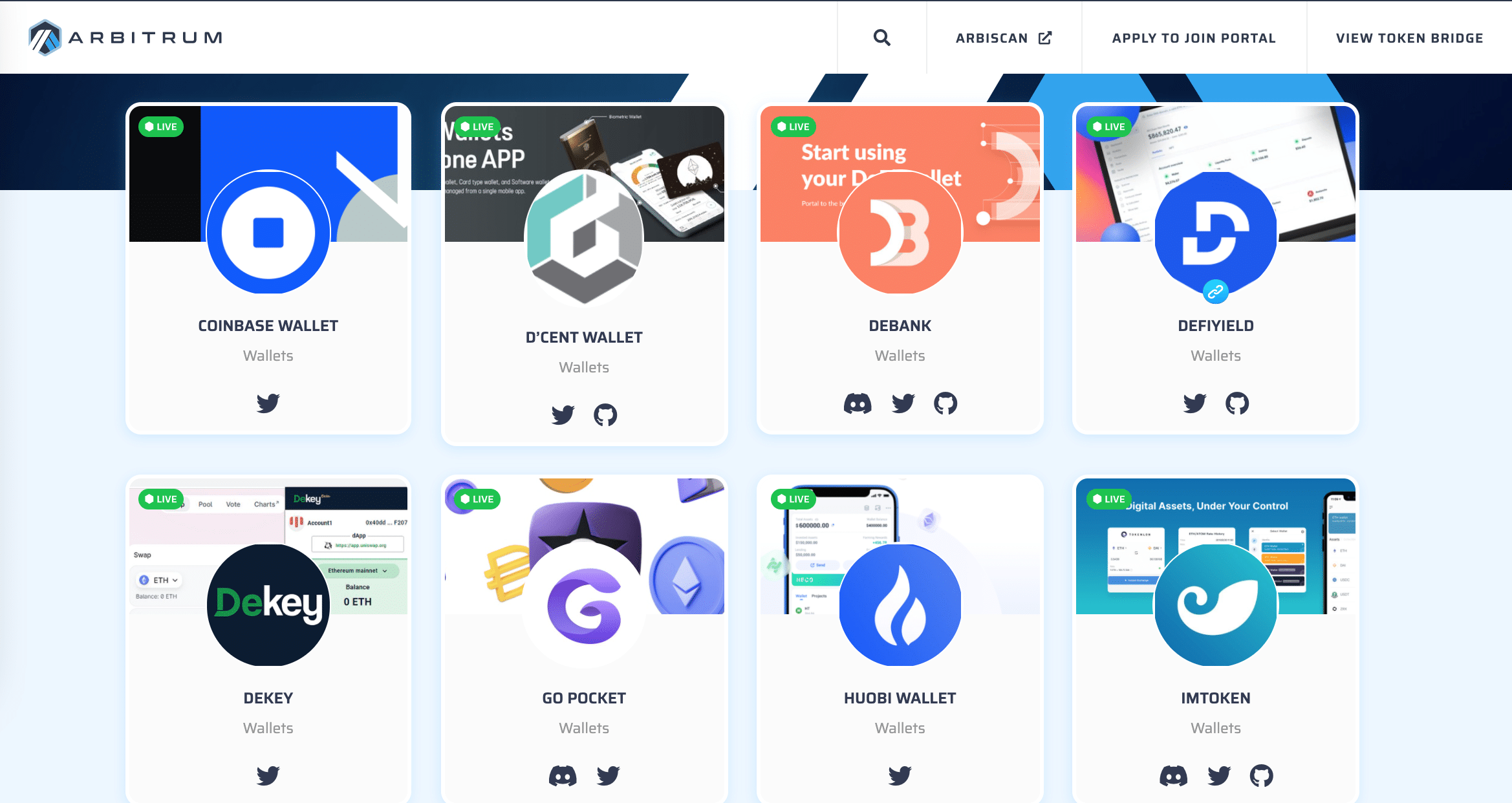
Some examples of wallets that supports Arbitrum
DApps
A rich collection of dApps have already made Arbitrum their second home, if not their only home. You can find almost all the top DeFi names here, including Uniswap (the most traffic), Aave, Curve, DAI/MakerDAO, Balancer to some of the more esoteric ones like Frax Finance, Cream Finance, Beefy Finance and even non-DeFi dApps like IdeaMarket (highly-ranked URLs become the public narrative) and Kaki (play-to-earn NFT games).
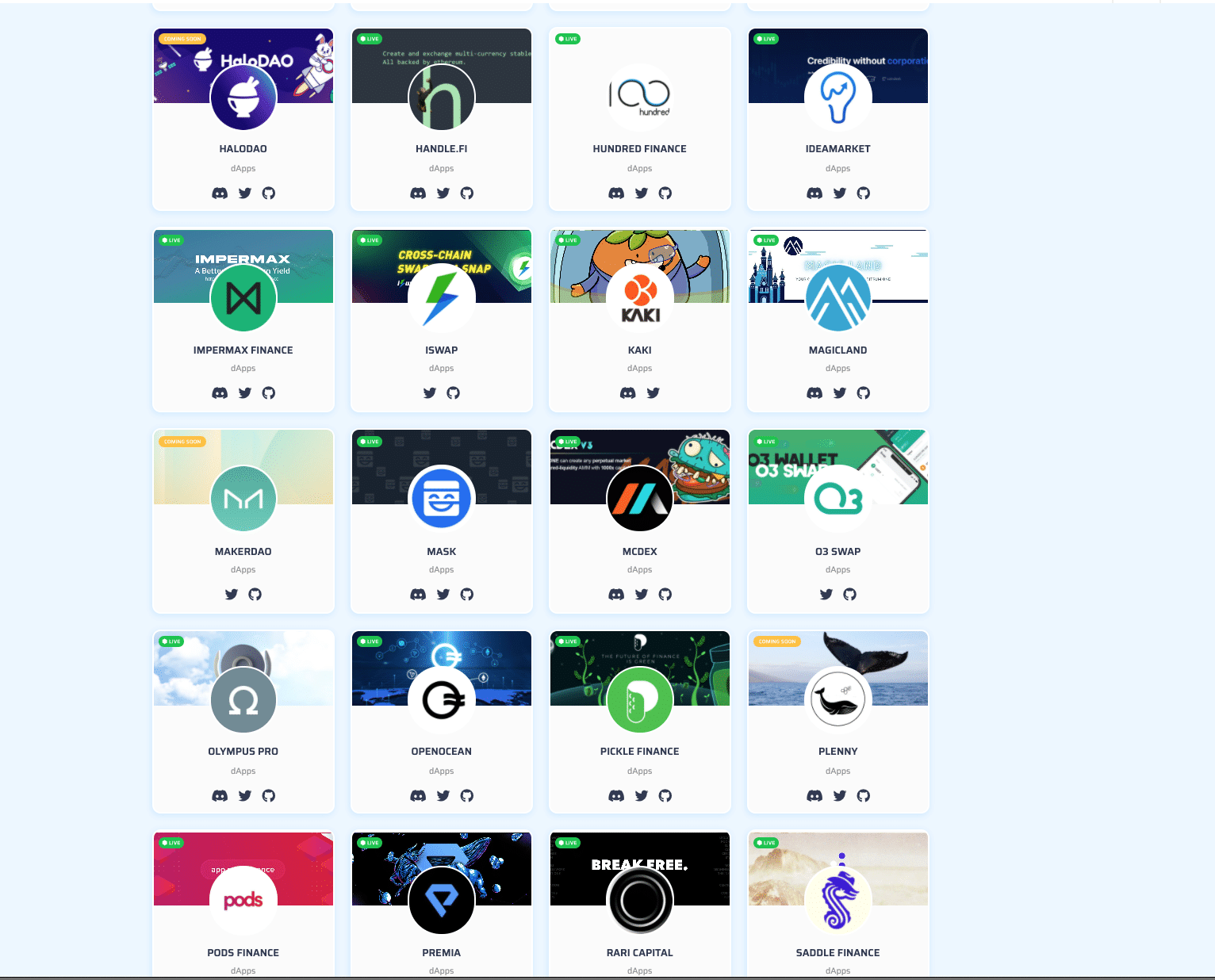
So many to discover and try at a fraction of the cost.
Tools
The tools listed in this section are mainly for developers to use when building their Ethereum projects on Arbitrum. Only a few familiar names stick out to the average user, like Etherscan (public records on Ethereum network) but are the Arbitrum version, Tether (USDT), USDC and perhaps The Graph.
Bridges & On-Ramps
Bridges play one of the most essential roles in the crypto sphere due to the siloed nature of the blockchains. When the blockchain projects were initially conceived, it was like a start-up company where the focus was on making it the best it could be. However, as the proliferation of projects grew and the founders had the opportunity to interact with each other, they recognise how some projects might be of use to their own and vice versa, especially in the world of DeFi, where users can often use tokens generated from one blockchain and use them to get yield at another blockchain. Bridges became the necessary component to move these tokens from one blockchain to another.
The list of bridges currently on Arbitrum is also some of the more popular ones used. They include but are not limited to, AnySwap, Banxa, Binance, Hop Protocol and Crypto.com.
NFT Marketplaces
Compared to the plethora of choices in the other categories, this one is the thinnest, featuring only two NFT marketplaces, TofuNFT and Treasure. While OpenSea may have the lion’s share of the NFT market, the popularity of NFTs is growing by the day. With that comes the demand for cheap gas fees. It won’t be long before more listings are added to Arbitrum as the NFT space continues exponential growth.
Arbitrum Token Bridge
After having feasted your eyes on the wide selection of dApps to try out, the most important step is to fund your wallet with ETH to get started. When you buy ETH for the first time, especially if using fiat money, it’s most likely ETH located on the Ethereum network that is L1. Interacting with the Arbitrum dApps requires the extra step of moving the ETH from L1 to L2, which is where the Arbitrum token bridge comes in. This handy tool is specifically designed to transfer not just ETH but any flavour of ERC tokens from L1 to L2. It’s not just a one-way bridge, either. You can also move your ETH from L2 back to L1 again anytime.
To use this tool, connect your Web3 wallet to the site. Since Arbitrum has no native token, all fees are paid in ETH, so be sure to have some available for making payments.

Use this to move your ETH from L1 to L2 by clicking Deposit to get started
Offchain Labs
The team building Arbitrum carries an impressive resumé. Based in New York, prior experiences range from Deputy US CTO at the White House and senior Advisor to the President (Ed Felten) to co-author of the leading textbook in cryptocurrencies, Bitcoin and Cryptocurrency Technologies (Steve Goldfeder) to technical consulting for cryptocurrency projects. In addition, many rank-and-file employees are also crypto-enthusiasts and have their areas of interest in the crypto-verse.
They have managed to secure funding with major well-known ventures in the blockchain space. Major investors include Lightspeed, Pantera and Polychain Capital. Together with other VCs such as Coinbase Ventures, Blockchain, Fenbushi Capital, and Mark Cuban Companies, to name a few, a total of $120 million of series B funding was raised for the venture.
With this amount of institutional support, it’s safe to say that Arbitrum is no fly-by-night operation, and the calibre of its team is proof of its staying power in the crypto world. They’re also looking to expand their team to cater for their dramatic growth.
Arbitrum Reddit Project
One of the more exciting projects the Offchain Labs team was involved in was a collaboration with Reddit. When Reddit decided to launch its ERC20 token, known as Community Points, to its members, it had a “Scaling Bake Off” to pick the best blockchain for collaboration. Arbitrum beat out 21 other competitors to win the competition. Reddit users earn these tokens by providing quality comments or contributing in other ways. The tokens can be spent on items within the Reddit ecosystem.
Risk & Pain Points
As much of a powerhouse as Arbitrum has been with its success, it is not without some weaknesses. Here are two key areas to pay attention to:
Optimistic vs zkRollups
The design of optimistic rollups involves a challenge period, which can be up to 2 weeks, as it gives people ample opportunity to check that all blocks are actual transactions. For those who want to withdraw their tokens, this can be a long wait time before getting their tokens back. Here is where zkRollups shine.
Unlike Optimistic rollups with the challenge period, zkRollups, also known as zero-knowledge Rollups, generate a validity proof known as SNARK to validate the authenticity of the transactions. SNARK contains only key details of the transaction, not the complete data. This rollup method does not require a challenge period, which makes moving funds around a lot faster.
Fund Security
According to L2Beat, a website that compares L2 projects together with analysis on them, there are a few ways that the security of funds can be compromised on Arbitrum, including, but not limited to:
- Mistakes in the AVM implementation could lead to lost funds.
- The centralised validator going down, which means users cannot create new blocks. However, exiting the system requires a new block to be produced. In this case, funds can be frozen. This recently happened due to the current centralised structure.
- No delays in code upgrades might mean that a malicious code can slip in without knowing. This kind of incident could result in stolen funds.
If you’re interested to find out more, you can take a look here.
Lack of Native Token
As of the time of writing, the Arbitrum team has not made any announcements about issuing a native token. Arbitrum knows that one of its weaknesses is the centralised validator and have plans to make things more decentralised in the near future. To get more people on board, there needs to be an incentive. The quickest way to get that going would be through a token issuance.
Conclusion
In 2021, we saw the rise of L1 alternatives like Solana, Avalanche and Fantom chomping away at Ethereum’s market share. These L1s honed in on Ethereum’s weaknesses and jumpstarted their ecosystems of dApps to provide an alternative to Ethereum’s offerings. These alternative L1s may have gotten a headstart with faster transaction speed and low-cost fees, but is it as secure as Ethereum? They also have their growing pains to contend with, as can be seen with Solana’s on-off outages in the past few months. As the excitement and novelty of the alternative L1s start to wear off, 2022 is likely the year that we will see Ethereum’s L2s come into the spotlight.
In the space of L2s, Arbitrum is the top dog and the one to beat. How long it can retain its winning crown depends on its development pace to secure the blockchain. News of a bug causing a 7-hour outage within five months of another bug is not something it wants to be known for. “The Arbitrum network is still in beta, and we will keep this moniker as long as there are points of centralisation that still exist in the system”, Offchain Labs said. The way forward for Arbitrum is to get decentralised as soon as it can, with or without a native token.
There is talk that L1s will mainly be for the bots in the future as humans will likely be interacting with dApps built on L2s. When you think of it, internet users don’t need to know about IP addresses or website domain hosting to shop online or check their email. It is very plausible in the not-so-distant future that things like gas fees and which blockchain is hosting the dApps will also be of no interest to the general public as these friction/touchpoints will already have been ironed out or “rolled up” under a slick UI and compelling service/ product. When that time comes, Arbitrum would only be a brand name known to developers but largely unknown by the general public.
The post Arbitrum: The Complete 101 Guide appeared first on Coin Bureau.
- &
- 100
- 2020
- 2021
- 2022
- About
- Add-on
- addition
- advice
- advisor
- All
- already
- Although
- analysis
- Announcements
- Another
- architecture
- around
- audience
- authenticity
- available
- Avalanche
- avatar
- average
- balancer
- BEST
- beta
- Billion
- binance
- Bitcoin
- blockchain
- blockchain projects
- board
- boosting
- bots
- BRIDGE
- Bug
- build
- Building
- buy
- Can Get
- capital
- challenge
- challenges
- Co-Author
- code
- Coin
- coinbase
- Coinbase Ventures
- CoinBureau
- collaboration
- collection
- collects
- comments
- community
- Companies
- company
- compelling
- competition
- competitors
- component
- Consensus
- consulting
- contains
- contents
- continues
- contract
- contracts
- Costs
- could
- crypto
- cryptocurrencies
- cryptocurrency
- CTO
- Current
- DApps
- data
- day
- Deals
- DeFi
- delays
- Demand
- Design
- develop
- developed
- Developer
- developers
- developing
- Development
- discover
- domain
- domains
- down
- Early
- easily
- ecosystem
- Ecosystems
- employees
- Environment
- ERC20
- especially
- ETH
- ethereum
- ethereum network
- everything
- evolution
- execution
- Expand
- Experiences
- faster
- Features
- Fees
- Fiat
- Fiat Money
- Finally
- finds
- First
- first time
- Focus
- Forward
- founders
- fund
- funding
- funds
- future
- Games
- GAS
- gas fees
- General
- generate
- getting
- going
- great
- Growing
- Growth
- guide
- handy
- happy
- having
- help
- helps
- here
- High
- Highlight
- Home
- hosting
- House
- How
- HTTPS
- Humans
- image
- important
- Including
- inclusion
- industry
- Institutional
- interactive
- interest
- Internet
- investment
- Investors
- involved
- IP
- IP addresses
- issuance
- issues
- IT
- July
- Justice
- Key
- knowledge
- known
- Labs
- Languages
- launch
- lead
- leading
- Limited
- List
- Listings
- locked
- Long
- looked
- looking
- major
- Making
- mark
- Mark Cuban
- Market
- Members
- million
- modular
- money
- months
- more
- most
- move
- names
- Nature
- Near
- network
- New York
- NFT
- NFTs
- offer
- Offerings
- Offers
- online
- open
- OpenSea
- operating
- operating system
- Opinions
- Opportunity
- Option
- Other
- Others
- outage
- Pain
- Pay
- payments
- People
- Play
- Popular
- Posts
- power
- president
- process
- Produced
- Product
- project
- projects
- proof
- Proof-of-Stake
- protect
- provide
- public
- quality
- question
- range
- readers
- records
- required
- research
- rounds
- running
- safe
- Said
- Scalability
- scaling
- security
- sense
- Series
- Series B
- set
- Share
- shine
- similar
- smart
- smart contract
- smart contract languages
- Smart Contracts
- So
- Solana
- solidity
- SOLVE
- something
- Space
- specifically
- speed
- Spotlight
- start
- Start-up
- started
- stolen
- success
- successful
- support
- Supports
- system
- Talk
- Target
- Technical
- Technologies
- Telegram
- Tether
- Tether (USDT)
- The Block
- The Future
- The Projects
- the world
- Through
- time
- together
- token
- Tokens
- tool
- tools
- top
- trader
- traffic
- transaction
- Transaction Fees
- Transactions
- TVL
- ui
- us
- users
- value
- VCs
- venture
- Ventures
- version
- Virtual
- virtual machine
- wait
- Wallet
- Wallets
- Web3
- Website
- What
- What is
- White House
- WHO
- win
- within
- without
- working
- works
- world
- would
- writing
- year
- Yield


